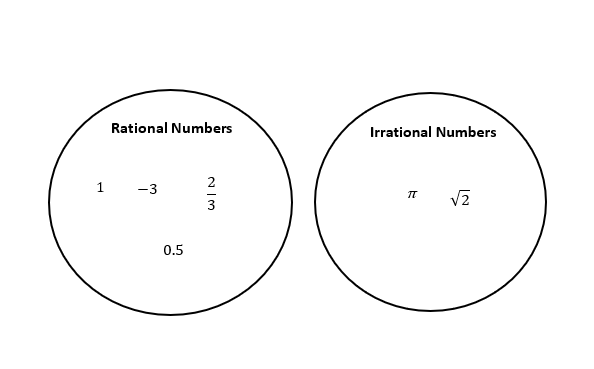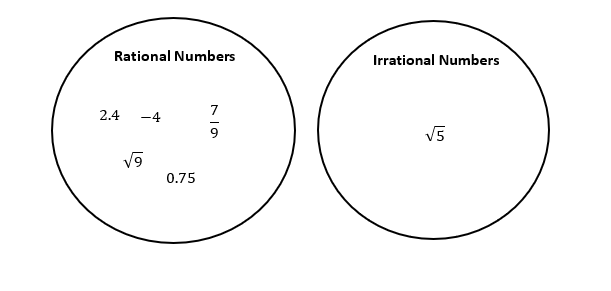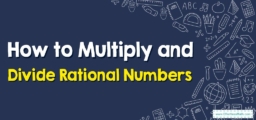How to Use a Venn Diagram to Classify Rational Numbers?
A Venn diagram is a visual representation of the relationships between different sets or groups.
A Venn diagram consists of one or more circles or other shapes that overlap and represent different sets or groups.
The overlapping areas show the elements that belong to both sets, while the non-overlapping areas represent the elements that belong to only one set.

A Step-by-step Guide to Using a Venn Diagram to Classify Rational Numbers
To use a Venn diagram to classify rational numbers, you can follow these steps:
Step 1: Draw a large rectangle to represent the set of all real numbers.
Step 2: Draw two overlapping circles inside the rectangle, one to represent the set of rational numbers and the other to represent the set of irrational numbers.
Step 3: Label the circle representing rational numbers as \(“Q”\) and the circle representing irrational numbers as \(“I”\).
Step 4: Write down the definition of rational numbers, which are numbers that can be expressed as a ratio of two integers. This means that any number that can be written in the form of \(\frac{p}{q}\), where \(p\) and \(q\) are integers and \(q\) is not equal to zero, belongs to the set of rational numbers.
Step 5: Shade the region inside the circle \(“Q”\) to show all the rational numbers. This includes all fractions, integers, terminating decimals, and repeating decimals.
Step 6: Shade the region inside the circle \(“I”\) to show all the irrational numbers. These include numbers that cannot be expressed as a ratio of two integers, such as the square root of \(2\) or pi.
Note that the region outside both circles represents the set of real numbers that are neither rational nor irrational, such as complex numbers.
By using a Venn diagram, you can visualize the relationship between different sets of numbers and classify them accordingly.
Using a Diagram to Classify Rational Numbers – Examples 1
Classify the following numbers as rational or irrational: \(1, 0.5, -3, \frac{2}{3}, \sqrt{2}, π\)
Solution:
Step 1: Draw a large rectangle to represent the set of all real numbers.
Step 2: Draw two overlapping circles inside the rectangle, one to represent the set of rational numbers and the other to represent the set of irrational numbers.
Step 3: Label the circle representing rational numbers as \(“Q”\) and the circle representing irrational numbers as \(“I”\).
Step 4: Shade the region inside the circle \(“Q”\) to show all the rational numbers. This includes all fractions, integers, terminating decimals, and repeating decimals.
Step 5: Shade the region inside the circle \(“I”\) to show all the irrational numbers. These include numbers that cannot be expressed as a ratio of two integers, such as the square root of \(2\) or pi.
Now we can classify the given numbers:
\(1\): Rational (an integer)
\(0.5\): Rational (a terminating decimal)
\(-3\): Rational (an integer)
\(\frac{2}{3}\): Rational (a fraction)
\(\sqrt{2}\): Irrational (a number that cannot be expressed as a ratio of two integers)
\(π\): Irrational (a number that cannot be expressed as a ratio of two integers)

Using a Diagram to Classify Rational Numbers – Examples 2
Classify the following numbers as rational or irrational: \(-4, \frac{7}{9}, \sqrt{9}, 0.75, \sqrt{5}, 2.4\)
Solution:
Step 1: Draw a large rectangle to represent the set of all real numbers.
Step 2: Draw two overlapping circles inside the rectangle, one to represent the set of rational numbers and the other to represent the set of irrational numbers.
Step 3: Label the circle representing rational numbers as \(“Q”\) and the circle representing irrational numbers as \(“I”\).
Step 4: Shade the region inside the circle \(“Q”\) to show all the rational numbers. This includes all fractions, integers, terminating decimals, and repeating decimals.
Step 5: Shade the region inside the circle \(“I”\) to show all the irrational numbers. These include numbers that cannot be expressed as a ratio of two integers, such as the square root of \(2\) or pi.
Now we can classify the given numbers:
\(-4\): Rational (an integer)
\(\frac{7}{9}: Rational (a fraction)
\(\sqrt{9}\): Rational (an integer)
\(0.75\): Rational (a terminating decimal)
\(\sqrt{5}\): Irrational (a number that cannot be expressed as a ratio of two integers)
\(2.4\): Rational (a terminating decimal)

Related to This Article
More math articles
- Trigonometric Integrals: A Thorough Guide On Everything You Need To Know
- How to Transform Linear Functions
- Deciphering Chance: A Comprehensive Guide to Mutually Exclusive Events in Probability
- FREE SIFT Math Practice Test
- How to Discover the Key to Math Mastery: “TABE Math for Beginners” Solution Manual Unveiled
- Top 10 ASVAB Math Practice Questions
- The Fundamental Theorem of Algebra
- 4th Grade MCAP Math Worksheets: FREE & Printable
- Top 10 Geometry Books for High School Students
- 8th Grade M-STEP Math Worksheets: FREE & Printable


























What people say about "How to Use a Venn Diagram to Classify Rational Numbers? - Effortless Math: We Help Students Learn to LOVE Mathematics"?
No one replied yet.